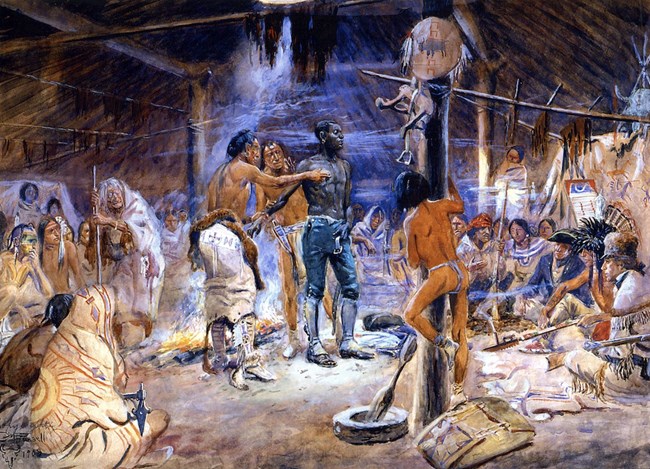Last updated: March 10, 2025
Article
York After the Expedition

While all the members of the corps likely had a hard time re-adjusting to life after the Lewis and Clark Expedition, no one could have struggled more than York, the enslaved servant of William Clark. York surely got a taste of new possibilities, serving as a valuable member on the journey. So, when all the other men received their pay and land grants from a grateful Congress, he possibly thought that in lieu of all that, his pay might be his freedom.
When York asked Clark, Clark refused. Clark handled it poorly. He did allow York to temporarily return to Louisville to rejoin his wife, who was enslaved by a different master.
In frustration, Clark wrote to his older brother Jonathan, “if any attempt is made by york to run off, or refuse to provorm his duty as a Slave, I wish him Sent to New Orleans and Sold, or hired out to Some Severe master untill he thinks better of Such Conduct.”
Clark’s callousness toward York, probably the one person he knew better than anyone else throughout his entire life, hits us hard and in the face of his image as an upstanding individual.
In 1832, when Clark met with author Washington Irving, Clark gave his account on the situation, claiming that he had eventually freed from enslavement, but York’s life as a freeman had been a failure. According to Irving, Clark provided this account of York’s last days: “He could not get up early enough in the morning—his horses were ill-kept—two died—the others grew poor. He sold them, was cheated—entered into service—fared ill. Damn this freedom, said York, I have never had a happy day since I got it. He determined to go back to his old master—set off for St. Louis, but was taken with the cholera in Tennesee & died.” Is this account accurate, or is Clark using racist stereotyping of the era to justify why York never should have been free at all?
Two months after Clark’s meeting with Irving, a fur trader named Zenas Leonard claims to have encountered a black man living among a band of Crow Indians in today’s Wyoming – someone who claimed to be York. Seven years later, Leonard published an account of his years in the West, and included some interesting information on this encounter: “In this village we found a negro man, who informed us that he first came to this country with Lewis & Clark — with whom he also returned to the State of Missouri, and in a few years returned again with a Mr. Mackinney, a trader on the Missouri river, and has remained here ever since – which is about ten or twelve years.”
Two very different perspectives on one of the many mysteries of the Lewis and Clark story. What do you think of York’s fate?
Photo: Charles M. Russell’s renowned painting of York, created in 1908 in watercolor. Original size: 19” by 25.5”. It is within the collection of the Montana Historical Society in Helena.
Alt Text: The well-known watercolor painting shows York standing in the middle of a Hidatsa lodge. Chief Le Borgne is shown with other tribe members curiously looking at York’s dark skin.
